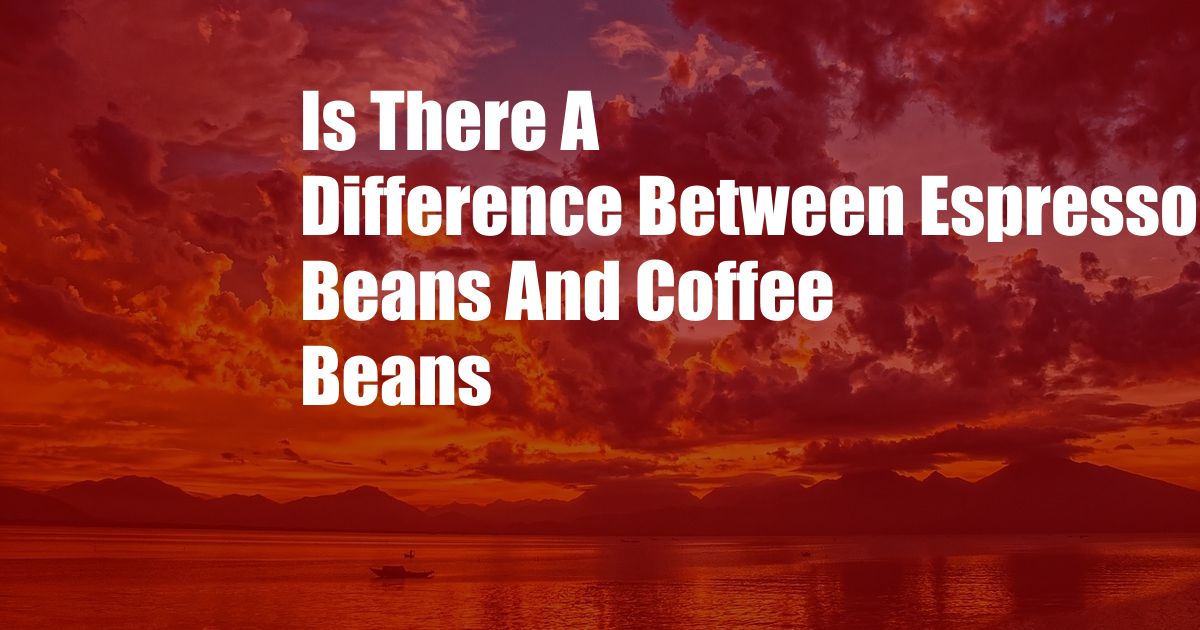
Espresso vs. Coffee Beans: A Comprehensive Guide to the Differences
As a coffee enthusiast with an extensive palate, I’ve had the pleasure of exploring the vast world of coffee beans. One question that often comes up is: is there a difference between espresso beans and coffee beans? The answer lies in a fascinating journey of discovery, where I’ll delve into the origins, roasting techniques, flavor profiles, and brewing methods that distinguish these two coffee wonders.
Coffee beans and espresso beans are both derived from the Coffea plant, specifically the Coffea arabica and Coffea canephora species. They share the same fundamental characteristics, yet subtle differences emerge in their processing and preparation, giving rise to unique taste profiles and brewing experiences.
The Art of Espresso
Espresso beans undergo a meticulous roasting process that transforms them into dark, oily, and highly flavorful gems. The roasting process intensifies their natural sweetness and amplifies their unique flavor compounds. Espresso beans are ground finely, allowing for a denser extraction of flavor and aroma during brewing. When combined with pressurized hot water, they yield the rich, concentrated, and velvety espresso we all love.
Diving into the World of Coffee Beans
Coffee beans, on the other hand, cover a broader spectrum of roasting profiles and brewing methods. They can be roasted light, medium, or dark to produce a range of flavors, from bright and fruity to rich and chocolatey. Ground coffee beans are typically coarser than espresso beans, accommodating a variety of brewing methods like drip, pour-over, and French press. Each method highlights different flavor nuances, allowing coffee enthusiasts to explore a wider realm of coffee experiences.
Unveiling the Flavor Spectrum
Espresso beans boast a bold, intense, and concentrated flavor. Their dark roasting brings forth notes of caramel, chocolate, and spice, complemented by a lingering bitterness. Coffee beans, with their diverse roasting profiles, offer a broader flavor spectrum. Light roasts showcase bright, fruity, and acidic notes, while medium roasts bring balance and complexity. Dark roasts, like espresso beans, emphasize bold and smoky flavors.
The Brewing Ritual
Espresso machines reign supreme in the realm of espresso brewing. They force pressurized hot water through finely ground coffee, yielding a concentrated shot in a matter of seconds. This process extracts a bolder flavor with a rich crema, the golden-brown foamy layer that crowns the perfect espresso.
Coffee beans, on the other hand, shine under various brewing methods. Whether it’s the drip method’s balanced extraction, the pour-over’s delicate nuances, or the French press’s full-bodied richness, each method unveils a unique aspect of the coffee bean’s flavor profile. The coarser grind allows for a slower, more gentle extraction, resulting in a less concentrated but more nuanced flavor.
Latest Trends and Developments
The coffee industry is constantly abuzz with new trends and advancements. One notable trend is the rise of specialty coffee, which emphasizes high-quality beans, sustainable sourcing, and meticulous roasting. This movement has brought forth a deeper appreciation for the intricacies of coffee and its origins.
Technological innovations are also shaping the coffee landscape. Smart coffee makers and subscription services are making it easier than ever to enjoy a barista-quality experience at home. These advancements cater to the growing demand for convenience and personalized coffee experiences.
Expert Tips and Advice
As an avid coffee blogger, I’ve accumulated a wealth of tips and expert advice to enhance your coffee journey. Here are a few gems to elevate your coffee experience:
- Grind Fresh: Always grind your coffee beans just before brewing to preserve their aromatic compounds.
- Experiment with Ratios: Adjust the coffee-to-water ratio to find your ideal flavor balance. A good starting point is 1:15, meaning 1 gram of coffee to 15 grams of water.
- Clean Your Equipment: Regularly cleaning your coffee equipment removes oils and residue that can affect the flavor of your coffee.
Frequently Asked Questions
Q: Can I use espresso beans in a regular coffee maker?
A: Yes, you can use espresso beans in a regular coffee maker. However, the finer grind may result in over-extraction and a bitter taste. It’s best to adjust the grind size and ratio to suit your machine.
Q: What’s the difference between a single shot and a double shot of espresso?
A: A single shot of espresso is typically 1 ounce, while a double shot is 2 ounces. The double shot contains more caffeine and has a more robust flavor profile.
Q: How do I store coffee beans for maximum freshness?
A: Store coffee beans in an airtight container away from light, heat, and moisture. Whole beans stay fresh for up to 2 weeks, while ground coffee loses its flavor more quickly.
Conclusion
The world of coffee beans and espresso beans is a symphony of flavors and brewing techniques, offering a vast and ever-evolving landscape to explore. Whether you prefer the bold intensity of espresso or the nuanced richness of regular coffee, understanding the differences between these two beloved beans will empower you to craft the perfect cup every time. Are you ready to embark on this caffeinated journey and experience the subtleties and wonders of the coffee bean kingdom?